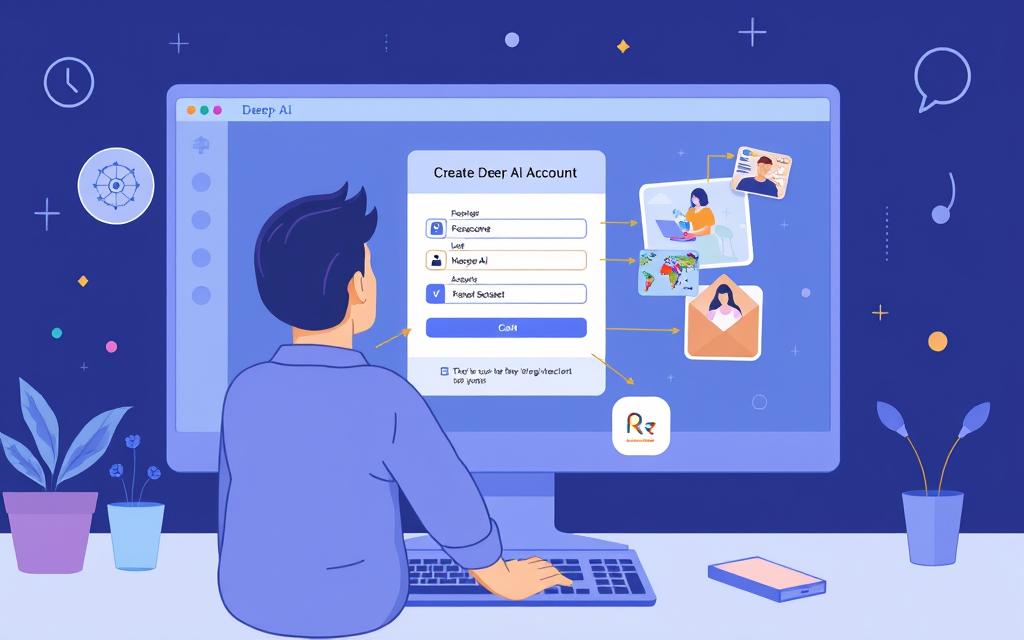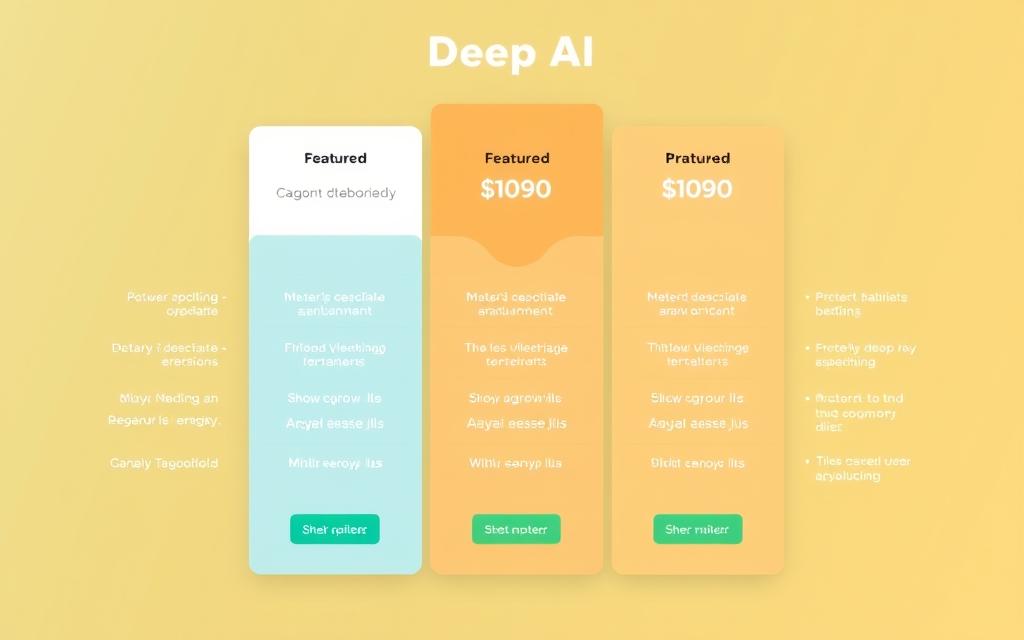Table of Contents
As we dive deep into the world of artificial intelligence, one term that has gained significant attention is Deep AI. This advanced technology is revolutionizing the way we interact with machines, offering a range of innovative features and tools that are transforming industries.
This introduction to Deep AI highlights its significance in the current AI landscape, showcasing its capabilities as both a text generator and image creation platform. By understanding how Deep AI fits into the broader ecosystem of AI systems, businesses and individuals can unlock new opportunities and stay ahead of the curve.
Understanding Deep AI Technology
The advent of Deep AI technology has marked a significant shift in how AI systems understand and generate text. This technology is built on advanced language processing capabilities and sophisticated algorithms that enable it to interpret and respond to complex prompts.
The Core Technology Behind Deep AI
Deep AI utilizes the Azure OpenAI o3-deep-research model for its research tasks, fine-tuned on the Azure OpenAI o3 reasoning model. This foundation allows Deep AI to process and analyze data effectively, generating coherent and contextually relevant text.
How Deep AI Differs from Other AI Systems
Unlike traditional AI systems, Deep AI’s advanced algorithms and language processing capabilities enable it to handle a wide range of text inputs and requests with greater precision. This makes Deep AI particularly adept at generating high-quality content and responding accurately to user prompts.
The unique technological advantages of Deep AI lie in its ability to understand and interpret data, allowing it to provide more nuanced and contextually appropriate responses compared to other AI systems.
Deep AI: Features and Capabilities
Deep AI’s comprehensive suite of features makes it a versatile tool for various applications. It offers a range of capabilities that cater to different user needs, from generating text to creating images.
AI Chatbot Functionality
Deep AI’s chatbot functionality is designed to process user queries efficiently. It can understand and respond to a wide range of questions and prompts, making it a valuable tool for customer service and support.
Image Generation Capabilities
Deep AI’s image generation capabilities allow users to create high-quality images based on text prompts. The tool offers various style options, enabling users to customize the output according to their preferences.
Text Generation and API Access
Deep AI’s text generation feature can produce a wide range of content, from articles to social media posts. Additionally, the API access allows developers to integrate Deep AI’s capabilities into their own projects, enhancing their applications with advanced AI functionality.
The text generation feature is particularly useful for content creators who need to produce high-quality text quickly. With the API access, developers can tap into Deep AI’s capabilities and build more sophisticated applications.
Getting Started with Deep AI
To unlock the full potential of Deep AI, understanding how to effectively use it is crucial. The process begins with a simple setup and intuitive navigation through its various features.

Setting Up Your Deep AI Account
Creating a Deep AI account is a straightforward process that involves a few simple steps. First, you need to sign up on the Deep AI platform, providing basic information. Then, you’ll go through an account verification process to secure your account. This step ensures that you can use the platform safely and effectively.
The initial configuration options allow you to tailor the platform to your specific needs, providing a personalized user experience. By customizing these settings, you can optimize your use of Deep AI, making it a valuable tool in your workflow.
Navigating the Deep AI Interface
Once your account is set up, navigating the Deep AI interface is intuitive. The platform is designed to be user-friendly, with different features and options clearly laid out on the main page. You can easily switch between various functionalities, such as chatbot services, image generation, and text generation, depending on your needs.
To enhance your experience, it’s worth exploring the different sections within the platform. This exploration will help you discover the full range of options available and how to make the most of them, ensuring that you get the best possible outcome from using Deep AI.
Deep AI Pricing Structure
Deep AI’s pricing plans are designed to provide value to users by offering a range of features and resource allocations tailored to different needs.

Capabilities of the Free Version
The free version of Deep AI offers a limited but valuable set of features, including a specific number of AI Generator calls and AI Chat messages. This plan is ideal for users who want to explore Deep AI’s capabilities without committing to a paid plan.
Key features of the free version include:
- Limited AI Generator calls
- Limited AI Chat messages
- Basic functionality to understand Deep AI’s capabilities
Premium Plans and Value Analysis
Deep AI’s premium plans offer enhanced features and increased resource allocations, providing greater value for users who require more advanced capabilities. The “Pay as you go” plan costs $5 per payment, offering 100 AI Generator calls, 350 AI Chat messages, an ad-free experience, private images, and API access. The “Deep AI Pro” plan is available for $4.99 per month, with 500 AI Generator calls, 1750 AI Chat messages, 60 Genius Mode messages, and 60 Genius Mode images, among other benefits.
When choosing a premium plan, users should consider their specific needs and how the additional features and resources will provide value to their work or business. The premium plans are designed to offer a more comprehensive experience, making them suitable for customers with demanding requirements.
By understanding the different pricing plans and their associated features, users can make informed decisions about which plan best suits their needs, maximizing the value they derive from Deep AI.
The Deep Research Tool Integration
The Deep Research tool is a powerful feature within the Deep AI ecosystem, designed to facilitate complex research tasks. It enables users to integrate a web-based research capability into their systems, leveraging the Azure AI Foundry Agent Service.
Multi-Step Research Capabilities
The Deep Research tool orchestrates a multi-step research pipeline, utilizing the Azure OpenAI’s o3-deep-research model in conjunction with Grounding with Bing Search. This allows for autonomous searching and reading of information from multiple online sources relevant to the user’s prompt. The multi-step research capabilities enhance information gathering by providing a comprehensive and structured approach to research.
Azure AI Foundry and Bing Search Integration
The integration of Azure AI Foundry and Bing Search significantly improves the quality and relevance of research results. By combining these technologies, the Deep Research tool can access a vast amount of data, ensuring that the information provided is both accurate and up-to-date. This integration is particularly beneficial for complex research projects, where the ability to synthesize data from multiple sources is crucial.
The Deep Research tool is designed to process and synthesize data from various sources, making it an invaluable asset for research projects. By optimizing research queries, users can obtain the most accurate and comprehensive results, further enhancing the tool’s effectiveness.
Performance Analysis of Deep AI
A comprehensive analysis of Deep AI’s performance sheds light on its operational efficiency and output quality. This section delves into the intricacies of Deep AI’s capabilities, focusing on its text and image generation quality.
Text Generation Quality Assessment
Deep AI’s text generation capabilities are a crucial aspect of its overall performance. The process involves complex algorithms that generate human-like text based on given inputs. An analysis of the generated text reveals that Deep AI can produce coherent and contextually relevant content. However, the quality of the output can vary depending on the complexity of the request and the ability of the model to understand the context.
The report generated by Deep AI includes not only the answer but also source citations and a description of the model’s reasoning path, making every answer fully auditable. This feature enhances the reliability and trustworthiness of the generated content.
Image Generation Quality Assessment
The process of image generation in Deep AI involves sophisticated models that create visual content based on textual descriptions. An evaluation of the output reveals that Deep AI can generate high-quality images that are relevant to the given prompts. The quality of these images is comparable to other leading image generation tools, showcasing Deep AI’s ability to produce visually appealing content.
Overall, Deep AI’s performance in both text and image generation demonstrates its potential as a versatile tool for various applications. By understanding the strengths and limitations of Deep AI through this analysis, users can better leverage its capabilities.
Practical Applications of Deep AI
With its advanced capabilities, Deep AI is transforming industries by enhancing content creation and research processes. Businesses and individuals can leverage Deep AI for a variety of applications, making it a versatile tool in the digital age.

Content Creation Applications
Deep AI is particularly useful for generating high-quality text content, including marketing materials and social media posts. Its tools enable users to create engaging content in various forms and formats, streamlining the content creation process.
For instance, Deep AI can be used to produce well-structured articles, product descriptions, and other written content that resonates with target audiences. This capability is especially valuable for businesses looking to maintain a consistent brand voice across different platforms.
Research and Data Analysis Use Cases
In addition to content creation, Deep AI excels in research and data analysis. Its advanced algorithms can process complex data sets, providing valuable insights that inform business decisions. By using Deep AI tools, researchers can analyze large volumes of information efficiently, saving time and improving accuracy.
Deep AI can also be applied to specific file types and content formats, making it a flexible solution for various research needs. Whether it’s analyzing market trends or processing scientific data, Deep AI proves to be an indispensable asset.
AI Content Detection Considerations
With the proliferation of AI-generated content, understanding detection considerations is crucial. As AI tools like Deep AI become more sophisticated, the line between human-generated and AI-generated content becomes increasingly blurred.
How Deep AI Content Is Detected
AI content detection systems identify Deep AI-generated content by analyzing linguistic patterns and word choices. These systems often rely on algorithms that detect similarity in sentence structure and word usage. For instance, when we tested Deep AI by asking it to write out our Wooly Runnys outline, Originality.ai immediately detected it as 100% AI-generated.
Strategies for Humanizing Deep AI Output
To make AI-generated content less detectable, it’s essential to humanize the output. This can be achieved by mixing AI-generated content with human input, using diverse information sources, and adjusting the tone to make it more relatable. By doing so, you can reduce the similarity between your content and typical AI-generated content, making it harder to detect.
Pros and Cons of Using Deep AI
When considering the use of Deep AI, it’s essential to weigh its advantages against its limitations. Deep AI is a versatile tool that has gained popularity for its capabilities in text and image generation.
Advantages of Deep AI
Deep AI offers several benefits, making it a solid choice for creating art or generating text. Its image generation capabilities are particularly noteworthy, producing high-quality images with the right prompts. The text creation API is another significant advantage, allowing users to generate a variety of text outcomes. Key benefits include:
- Cost-effectiveness and accessibility for different user types
- High-quality image and text generation capabilities
- Comprehensive tool with a range of features
Overall, Deep AI’s strengths make it an attractive option for those looking for a reliable tool for content creation.
Limitations and Drawbacks
Despite its advantages, Deep AI is not without its limitations. Some of the drawbacks include:
- Technical limitations that might impact certain use cases
- Limited ability to handle highly specialized or niche content requirements
- Customer support quality can vary, particularly for free users
Understanding these limitations is crucial for users to make informed decisions about their use of Deep AI.
Comparing Deep AI with Alternatives
When it comes to AI tools, the options can be overwhelming, but let’s dive deep into how Deep AI stacks up against its competitors. Deep AI offers a unique blend of text and image generation capabilities, making it a versatile tool.
Deep AI vs. ChatGPT
Deep AI and ChatGPT share similarities in text generation, but Deep AI’s ability to create images sets it apart. While ChatGPT excels in chat functionality based on GPT models, Deep AI provides a broader range of functionalities.
Deep AI vs. Other Image Generators
In terms of image generation, Deep AI holds its own against specialized tools. Although it may not match the quality of dedicated image generators, its integration with text generation capabilities offers a unique experience.
Conclusion: Is Deep AI Worth It?
In conclusion, Deep AI presents a compelling option for those looking to leverage AI technology without breaking the bank. It offers a robust set of text and image generation tools that cater to various needs, from content creation to research and data analysis.
While it may not be the most advanced tool with industry-defining features, Deep AI is an excellent introduction to the world of AI for less experienced users or those on a budget. Its user-friendly interface and comprehensive features make it a valuable resource for a range of applications.
Overall, we recommend checking out Deep AI for its potential to enhance your workflow and provide a solid foundation in AI-assisted content creation.
FAQ
What is the primary function of the Deep AI tool?
The primary function of the Deep AI tool is to provide advanced intelligence capabilities, including text and image generation, through its various features and models.
How does the AI chatbot functionality work within Deep AI?
The AI chatbot functionality within Deep AI is designed to simulate human-like conversations, providing users with a responsive and interactive experience through its natural language processing capabilities.
Can I use Deep AI for research and data analysis purposes?
Yes, Deep AI offers a research tool integration that enables users to conduct multi-step research and data analysis, leveraging sources like Azure AI Foundry and Bing Search.
What are the differences between the free version and premium plans of Deep AI?
The free version of Deep AI has limited capabilities compared to its premium plans, which offer additional features, support, and value for users who require more advanced functionalities.
How does Deep AI detect and process user input for text and image generation?
Deep AI uses complex algorithms and models to detect and process user input, generating output based on the context, prompt, and other relevant factors.
Can Deep AI be used for content creation, and what are its applications?
Yes, Deep AI can be used for content creation, offering a range of applications, including text and image generation, that can be tailored to specific user needs and requirements.
How does Deep AI compare to other AI systems, such as ChatGPT?
Deep AI differs from other AI systems, like ChatGPT, in its specific features, capabilities, and models, offering a unique set of functionalities that cater to diverse user needs.
What are the limitations and drawbacks of using Deep AI?
While Deep AI offers many benefits, it also has limitations and drawbacks, including potential biases in its models, the need for careful output evaluation, and the importance of human oversight.









